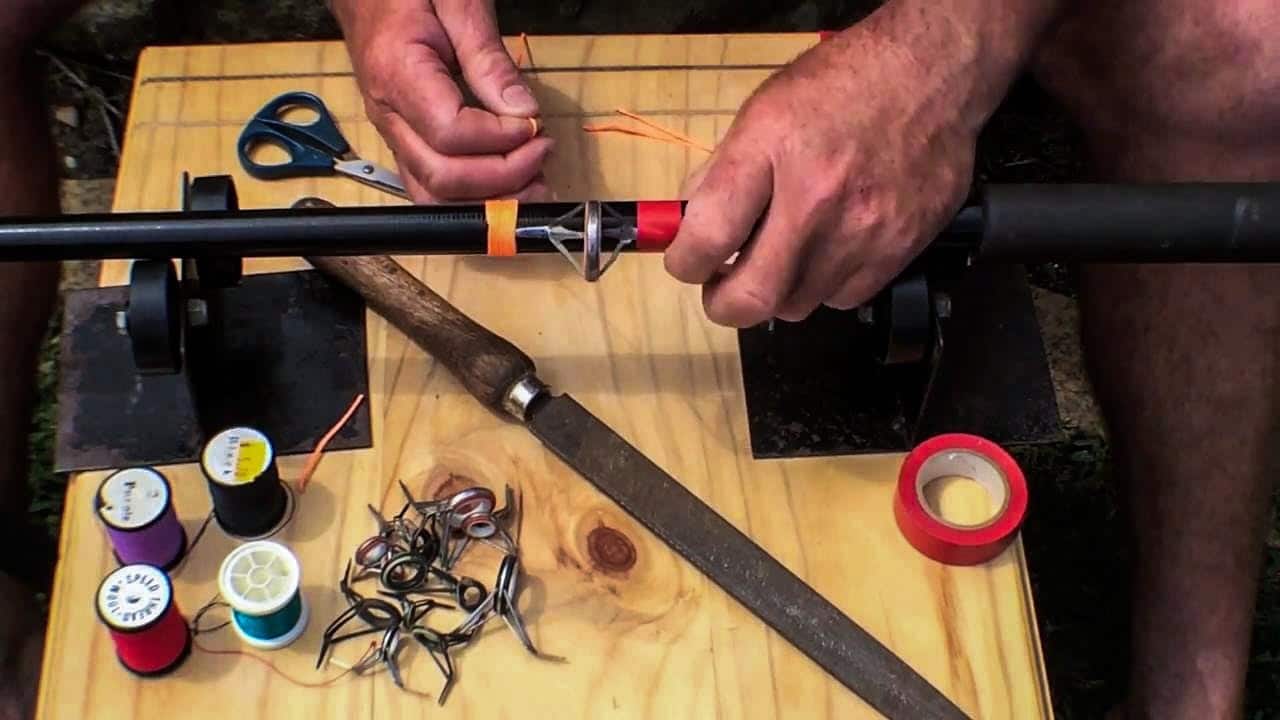
A fishing rod is a tool used to catch fish. They can be made from a range of different materials, the most common being wood, bamboo, and fibreglass (graphite). The desired flexibility of a fishing rod depends on its use. A good fishing pole should allow the fisher to drop the line in such a way that it looks like an innocent part of the water while also providing enough resistance to pull a fish from the depths. However, over time and with extensive use, catching rods can become damaged and require some simple repairs in order to get them back into catching fish shape. So let’s dig into our topic How To Fix A Fishing Rod.
The main problems that are likely to occur with a fishing rod are a broken or cracked line and a bent or twisted rod.
How to fix a fishing rod that is broken?
There are a few things you can do to fix a broken fishing rod. You should consider how you broke the fishing rod, how badly it is broken, and how much time you have before your trip.
If the break in the fishing rod is not too bad and it’s a freshwater fishing rod that has been broken then you can still use it if you know how to fix a fishing rod. For saltwater rods or small fish rods, there is no way that they will work after being damaged beyond repair. In this article, we will look at how to fix both types of rods for different scenarios:
Small freshwater catch with a soft plastic lure stuck in hook on the rod
if this happens, how to fix it depends on how long ago the lure became stuck.
Less than 24 hours ago: try to gently remove the lure. If it won’t budge, then cut the line as close to the lure as possible and continue fish catching.
More than 24 hours ago: reattach lure by using pliers to put it back on the hook. If you can’t find the original lure, replace it with a similar size and colour
Big freshwaters catch with a bent rod
how to fix it depends on how bad the bend is. Mild Bend: Gently twist or straighten the rod until it’s back to normal. You might need someone to help you with this. Severe Bend: You will need to replace the fishing rod
Saltwater Rod that has been bent
how to fix it depends on how bad the bend is.
Mild Bend: Gently twist or straighten the rod until it’s back to normal. You might need someone to help you with this Severe Bend: You will need to replace the fishing rod
Saltwater Rod that has been broken in half
how to fix it depends on how badly the fishing rod is damaged
Slightly Broken Rod: buy or find a new cheap stick and adhere a piece of that rod to the broken one using super glue around the breakpoint. wait for it to dry before using again (if repairing during your trip, use epoxy instead of superglue as super glue takes much longer) or wait until you get home and fix it permanently with epoxy resin (superglue may not be strong enough)
Completely Broken stick: buy or find a new fishing rod and start again
How to fix a bent or twisted fishing rod?
Bent and twisted fishing rods can usually be fixed with a little bit of patience and some common tools. The first step is to find the exact spot where the bend or twist is occurring. Once you have located it, use a vice grip or pliers to gently straighten the rod. If it’s a very severe bend, you may need to use a heat source such as a hairdryer or even an open flame (be very careful not to start a fire) in order to loosen the metal. Once it is straight, use a coat hanger or other piece of wire to hold the rod in place until the glue dries.
Many people also like to add a layer of protective sealant to their fishing sticks in order to help keep them from becoming damaged. A popular sealant is clear nail polish, which can be applied with a small brush. This will help protect against scratches and keep the rod looking new for longer.
Related Resource: How To Remove Rust From Fishing Hooks?
Tips and tricks for fixing fishing rods:
- If the break is near the end of the line, try using thread or dental floss to tie it back together.
- If you’re having trouble straightening the rod, apply heat until it’s flexible and then quickly cool it down with cold water.
- When using superglue, make sure the surfaces are clean and dry before clamping them together.
- Use a vice grip or pliers to gently straighten a bent or twisted stick.
- Always read the instructions on the adhesive before using it. This will ensure that you are using the correct type of adhesive for your specific application.
- Make sure that the surfaces you are bonding are clean and dry. Any dirt or oil on the surfaces can reduce how well the adhesive bonds.
- If possible, apply the adhesive in a temperature-controlled environment. This will ensure that your fishing rod is not affected by sudden temperature changes during its repair.
- Allow at least 24 hours for the adhesive to set before using it again. Temperatures above 70 degrees Fahrenheit may require that you wait longer than 24 hours before using your fishing rod again.
- Apply a coat of sealant such as clear nail polish to protect against scratches and keep the rod looking new.
- If the fishing rod is broken but still useable, try to gently remove any lure that is stuck in the hook. If you can’t remove it, then cut the line as close to the lure as possible and continue cathching fishing.
- If the bend in the fishing rod is mild, you can try to gently twist or straighten it until it’s back to normal. You might need someone to help you with this
- If the saltwater catching stick has been severely bent, you will need to replace the fishing rod
- Carry a spare fishing rod with you on your fishing trips in case of emergencies. This could be a cheaper rod that you can replace if it gets broken. Having a backup plan will save your trip and give you peace of mind while fishing.
Fixing fishing rods for lakes and freshwater fishing:
When fixing a fishing rod for lakes and freshwater fishing, it is important to use the correct type of glue. A good choice would be cyanoacrylate (CA) super glue. This type of glue dries quickly and is very strong. It can also withstand contact, making it perfect for this application. When applying the glue, it should be applied to both surfaces but only in thin layers (a little bit will go a long way). It can seep through the other side and break the line if you apply too much. Once the glue is dry, it should be completely clear and almost invisible.
If you’re having trouble straightening the rod while using CA superglue, you may need to use heat or an alternative type of glue altogether. When using heat, make sure that the area around you is ventilated because there’s always a chance that inflammable liquids are present (such as alcohol). As mentioned above, apply light heat until the metal becomes flexible and then quickly cool it down with cold water so that it firms up. Then proceed with fixing the break as normal.
Fixing fishing rods for saltwater fishing:
When fixing a fishing rod for saltwater fishing, it is important to use glue that can withstand contact with the ocean’s saltwater. A good choice would be epoxy. This type of adhesive is very strong and can bond with a variety of surfaces. It also dries quickly, which is perfect for this application. When applying the epoxy, it should be applied to both surfaces but only in thin layers (a little bit will go a long way). If you apply too much, it can seep through the other side and break the line. Once the epoxy is dry, it should be completely clear and almost invisible.
If you’re having trouble straightening the rod while using epoxy, you may need to use heat or an alternative type of glue altogether. When using heat, make sure that the area around you is ventilated because there’s always a chance that inflammable liquids are present (such as alcohol). Apply light heat until the metal becomes flexible and then quickly cool it down with cold water so that it firms up. Then proceed with fixing the break as normal.
Fixing fishing rods for small fish:
When fixing a fishing rod for small fish, it is important to use glue that will bond with a variety of surfaces. A good choice would be to use superglue. This type of adhesive is very strong and can bond with a variety of surfaces. It also dries quickly, so there is a minimal wait time before the fishing rod can be used again.
People also view: How To Change A Fishing Reel From Right To Left Handed?
Fixing fishing rods for big fish:
When fixing a fishing rod for big fish, it is vital to use glue that will withstand the stress of a larger fish. A good choice would be epoxy. This type of adhesive is solid and can withstand the stress of a bigger fish. It also dries quickly. This means that there is a minimal wait time before the fishing rod can be used again.
Conclusion:
Hope you read the full detail about How To Fix A Fishing Rod. Fixing a fishing rod can be a frustrating experience. Still, it is important to do in order to ensure that the fishing rod is in good condition and will last longer. By using the right type of adhesive, it is possible to fix a catching rod quickly and easily, so that the fishing rod can be used again as soon as possible.
